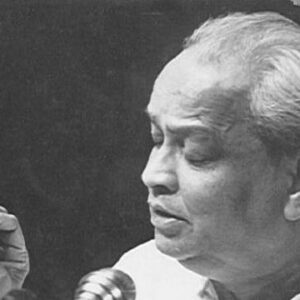Kumar Gandharva was one of the most famous classical musicians in India. He was a famous Hindustani classical singer. He was a child prodigy and a genius at coming up with new ways to put music together. He lost the use of a lung when he was young, which made him unable to work. Music gave him a new way to live. People say that his voice changed a lot in the years to come because of his health, so he had to find a new way to sing with short phrases and a very high pitch. He studied music in a quiet, thoughtful way while he was forced to take a temporary break from work. This helped him come out of the experience as a much more experienced and mature artist with sharpened creative skills. He was a well-known Hindustani classical singer from India. His singing style was unique because he didn’t follow the rules and traditions of any one musical Gharana. Even though he didn’t reach the same level of fame as some of his contemporaries, he still had a lot of loyal fans who loved and supported him. He had a unique way of saying words, and he thought that words could be very powerful if they were said in the right way. His style of singing also involved a lot of dramatic smiles and hand movements, which the people in the room loved. He was a talented singer who overcame huge odds to win and then devoted himself to the study and improvement of music.
Early years and childhood
Shivaputra Siddramayya Komkalimath was born on April 8, 1924, in Sulebhavi, Belgaum District, Karnataka, India. His parents were Kannadiga.
He was a musical genius who came up with new ideas and was a child prodigy. So, he got the name Kumar Gandharva, which comes from Hindu mythology, which says that Gandharva is a musical spirit.
In the 1930s, Prof. B R. Deodhar taught him how to play Indian classical music.
At a young age, he got tuberculosis, which is a deadly disease that left him with only one working lung. He was sick for six years and was very close to dying. During that time, he wasn’t allowed to sing.
Kumar Gandharva’s Career
He overcame this setback by making up his own style of singing, which used short, sharp bursts of music instead of the deep, sonorous, slow, and long phrases that are typical of Hindustani vocal music. In 1953, he gave his first performance of music since getting better.
He made a whole series of concert programs that had a common theme and a set of raagas and folk songs put in a certain order. Some of them are “Geet Varsha,” “Geet Hemant,” and “Ritu Raaj,” which have themes that change with the seasons. They showed his revolutionary spirit very well, which is why he is called a trendsetter.
He was able to find new raagas, which he called “Dhun Ugam Raagas,” over the course of his career. Many of the things he found, like Madhsurja, Ahimohini, Saheli Todi, Beehad Bairav, Lagan Gandhar, Sanjaari, and Maalvati, are now considered to be raagas and can be found in modern books like “Raga Nidhi.”
During his long and successful career, he also tried out different kinds of music, such as devotional songs called “bhajans” and folk songs. He used his own music to get himself out of a situation where he was almost dead. This showed that music has the power to heal by opening up new paths.
He was not only a great singer but also a scholar of music. He had his own ideas about the different types of raagas, ways to play them, and types of compositions. His comments about composite ragas, Thumri, and Tarana are very different from what most people say about these things.
He thought that every form of poetry had its own life and should be respected for its own sake, not just because it was part of a raaga. On November 22, 1991, he played his last public show in Bombay.
Works of note
His unique style and creativity led to compositions in the same raaga that were both fast and slow, which is something a north Indian musician rarely does. This was one of his most famous works. He may have been the only person in this century who was brave enough to do a whole concert of Malwa folk music.
One of his best musical experiments was the hour-long raaga expositions, in which he would often play as many as six different pieces at different speeds, many of which were his own creations.
Awards & Achievements
In 1990, he was given the “Padma Vibhushan,” which is the Republic of India’s second-highest civilian award.
Personal History and Legacies
He got married to Bhanumati Kans in April 1947 and moved to Dewas, Madhya Pradesh. Around 1955, God gave them Mukul, who was their first child. Bhanumati died in 1961 when their second child was born.
Then he got married to Vasundhara Shrikhande, one of his Deodhar School classmates. The couple sang bhajans together in a memorable way, and she often backed up his classical performances with her voice.
They were lucky enough to have a daughter, Kalapini Komkalimath, who also became a musician when she grew up.
He died in Dewas, India, on January 12, 1992, when he was 67 years old.
Estimated Net worth
It is thought that Kumar Gandharva has a net worth or income of between $9 million. He has so much money because of what he does for a living.


